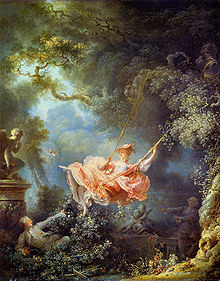As Berger stated,
"Men act and women appear."
Fragonard, The Swing c. 1767
Women were painted to be on display for the spectator owner to enjoy.
Being a (white) male back in the day meant having power, that also means having authority over everything and everyone. In our Patriartical society, even today, men are valued more than women.
"Women average less than 70 cents for eery dollar earned by men." (Guerrilla Girls 21)Men are respected more than women. In popular culture, unfortuntely, it is the norm that it's assumed that things are viewed from a man's point of view.
 The oppositional gaze is a look that black women should not just accept the stereotypical view that they are given and should be more judgemental. Black women were viewed as nagging women, or as "Mammies," (Bell Hooks 119) Women are degraded as just "eye-candy," and nothing more. An example of this is the Bechdel test where the criteria is quite simple. To pass it has to have at least two women who talk to each other about something besides a man. While it seems quite simple, there are very few movies that actually pass this test. This view has developed because as Bell Hooks stated,
The oppositional gaze is a look that black women should not just accept the stereotypical view that they are given and should be more judgemental. Black women were viewed as nagging women, or as "Mammies," (Bell Hooks 119) Women are degraded as just "eye-candy," and nothing more. An example of this is the Bechdel test where the criteria is quite simple. To pass it has to have at least two women who talk to each other about something besides a man. While it seems quite simple, there are very few movies that actually pass this test. This view has developed because as Bell Hooks stated, "Not only will I stare. I want my look to change reality." (Bell Hooks 116)Gazes are a very important way of communication. It is also a way to show rebellion or resistance. Why should black women be tied down to just a role of a nagging wife?
"Only, the child is afraid to look. Afraid to look, but be fascinated by the gaze. There is power in looking." (Bell Hooks 115)Now having knowledge about the Bechdel test, it's hard to watch movies without noticing how little interaction that women have between each other without talking about another man in the movie. This again plays into the idea of the male gaze, that a woman's view is secondary to a man's view. Many films directors (again usually white males) cater to the idea that a male is the primary viewer and that females are secondary. When female viewers are the main focus, the movies tend to not attract male viewers.
I never really paid any attention towards where the female in the painting during art history class, was looking until now. Most of the time the women were not looking at the other men in the painting but at the spectator, himself. Knowing this now makes me feel like the women in the paintings were somehow violated by the male gaze, and to make the male artist and/or the man who commissioned the artist feel better about it, they throw in a mirror next to the female nude and call it vanity. Since it relieves the viewer of guilt from looking at the nude, since the nude too, is looking at herself, I feel like that it is quite disgusting that they are treated like objects, like something to look at, instead of a work of art.
Works Cited
Burger, John
Ways of Seeing. London, England. 1972.
Hooks, Bell In Black Looks: Race Representation. Boston, Massachusetts: South End Press. 1992.

I like the short and to the point approach. You very simply gave examples and explanation of how women were devalued in ancient paintings and the stereotypes of black women historically and presesnt day.
ReplyDeleteI agree with your statement, "that a woman's view is secondary to a man's view". It is most definitely heavily reflected in today's society through media, pop culture, and even films (also noticed only after I learned about the Bechdel Tests).
ReplyDeleteAnd whereas the subjects of women in paintings are "treated like objects", I think more specifically, they are treated as "objects of desire".
This comment has been removed by the author.
ReplyDeleteI agree with you about the Bechdel test. It's now almost impossible for me to watch a TV show or a movie without noticing the little to no conversation that two women have that does not revolve around men. It kind of bugs me how little conversation women have that doesn't involve a guy in it. I believe that us women have more meaning to our lives than how the media portrays it.
ReplyDeleteI completely agree with you on the point that I never paid close attention to the females in any painting. Whether it be their expression, body language, or gestures, I just looked at the big picture and not the details hidden within. Especially when it came to nudes, I never noticed a mirror in their hand or a relaxed "take me" position they were in.
ReplyDeleteHi Carol,
ReplyDeleteI like how you transitioned from the male gaze to the oppositional gaze by showing how men were treated better than women and that, therefore, "men are respected more than women. In popular culture, unfortuntely, it is the norm that it's assumed that things are viewed from a man's point of view." That implicit connection was awesome.
Additionally, I liked not only how active your paper was in describing how you feel that the female was "violated" and that men were disgusting, but you gave examples (the man drawing the woman to make her his, and how he just "throw[s] in" the mirror to make it more humane).